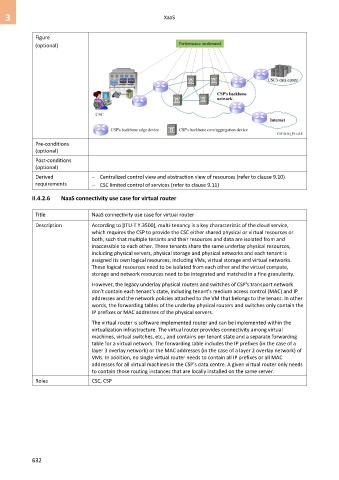Page 640 - Cloud computing: From paradigm to operation
P. 640
3 XaaS
Figure
(optional)
Pre-conditions
(optional)
Post-conditions
(optional)
Derived – Centralized control view and abstraction view of resources (refer to clause 9.10)
requirements – CSC limited control of services (refer to clause 9.11)
II.4.2.6 NaaS connectivity use case for virtual router
Title NaaS connectivity use case for virtual router
Description According to [ITU-T Y.3500], multi-tenancy is a key characteristic of the cloud service,
which requires the CSP to provide the CSC either shared physical or virtual resources or
both, such that multiple tenants and their resources and data are isolated from and
inaccessible to each other. These tenants share the same underlay physical resources,
including physical servers, physical storage and physical networks and each tenant is
assigned its own logical resources, including VMs, virtual storage and virtual networks.
These logical resources need to be isolated from each other and the virtual compute,
storage and network resources need to be integrated and matched in a fine granularity.
However, the legacy underlay physical routers and switches of CSP's transport network
don't contain each tenant's state, including tenant's medium access control (MAC) and IP
addresses and the network policies attached to the VM that belongs to the tenant. In other
words, the forwarding tables of the underlay physical routers and switches only contain the
IP prefixes or MAC addresses of the physical servers.
The virtual router is software implemented router and can be implemented within the
virtualization infrastructure. The virtual router provides connectivity among virtual
machines, virtual switches, etc., and contains per tenant state and a separate forwarding
table for a virtual network. The forwarding table includes the IP prefixes (in the case of a
layer 3 overlay network) or the MAC addresses (in the case of a layer 2 overlay network) of
VMs. In addition, no single virtual router needs to contain all IP prefixes or all MAC
addresses for all virtual machines in the CSP's data centre. A given virtual router only needs
to contain those routing instances that are locally installed on the same server.
Roles CSC, CSP
632

